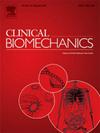前交叉韧带重建与双下肢深蹲修复后12周受试者膝关节负荷的比较
IF 1.4
3区 医学
Q4 ENGINEERING, BIOMEDICAL
引用次数: 0
摘要
背景尽管存在术后并发症,前十字韧带重建仍是治疗撕裂的金标准。近来,前交叉韧带修复技术的进步提高了治疗效果,人们重新开始关注将修复作为一种创伤较小的替代方法。本研究的目的是比较接受前十字韧带重建术或修复术的人在 12 周后双腿深蹲时的膝关节生物力学和股四头肌力量。使用 10 个摄像头的运动捕捉系统捕捉双腿深蹲时的关节运动,两个测力板收集地面反作用力。对膝关节伸展力矩峰值、膝关节屈曲角、膝关节屈曲角位移和股四头肌力量进行了测量。对参与者的人口统计学特征(年龄、身高、体重)、国际膝关节文献委员会主观膝关节评估表评分和等动股四头肌力量进行了独立 t 检验。对每个因变量进行单变量方差分析,并计算 Cohen's d效应大小。研究结果在考虑年龄因素后,修复组的膝关节伸展力矩明显大于重建组(P = .033,效应大小 = 1.00)。在股四头肌力量(P = .138)、膝关节屈曲角度峰值(P = .330)或膝关节屈曲角度位移(P = .372)方面,各组间未观察到有统计学意义的差异。除了之前发现的修复术优势外,12 周时修复术与重建术相比似乎还有一些生物力学方面的优势。本文章由计算机程序翻译,如有差异,请以英文原文为准。
Comparison of knee loading in subjects 12 weeks post-anterior cruciate ligament reconstruction versus repair when performing a double-limb squat
Background
Despite postoperative complications, anterior cruciate ligament reconstruction remains the gold standard treatment after a tear. Recent advancements in anterior cruciate ligament repair techniques have led to improved outcomes and renewed interest in repair as a less invasive alternative. The purpose of this study was to compare knee biomechanics and quadriceps strength during double-leg squat at 12 weeks between individuals who underwent anterior cruciate ligament reconstruction or repair.
Methods
A total of 43 participants (21 repair, 23 reconstruction) were included. A 10-camera Motion Capture System was used to capture joint motions during double-leg squat, and two force plates collected ground reaction forces. Peak knee extension moment, knee flexion angle, knee flexion angle displacement, and quadriceps strength were measured. Independent t-tests were performed for participant demographics (age, height, mass), International Knee Documentation Committee Subjective Knee Evaluation Form scores, and isokinetic quadriceps strength. A univariate ANCOVA was performed on each dependent variable and Cohen's d effect size was calculated.
Findings
The repair group demonstrated significantly greater knee extension moment compared to the reconstruction group after accounting for age (P = .033, effect size = 1.00). No statistically significant differences were observed between groups for quadriceps strength (P = .138), peak knee flexion angle (P = .330), or knee flexion angle displacement (P = .372).
Interpretation
This study adds to the growing body of literature demonstrating favorable outcomes of repair compared to reconstruction. In addition to previously identified advantages of repair, there appears to be some biomechanical advantage of repair compared to reconstruction at 12 weeks.
求助全文
通过发布文献求助,成功后即可免费获取论文全文。
去求助
来源期刊

Clinical Biomechanics
医学-工程:生物医学
CiteScore
3.30
自引率
5.60%
发文量
189
审稿时长
12.3 weeks
期刊介绍:
Clinical Biomechanics is an international multidisciplinary journal of biomechanics with a focus on medical and clinical applications of new knowledge in the field.
The science of biomechanics helps explain the causes of cell, tissue, organ and body system disorders, and supports clinicians in the diagnosis, prognosis and evaluation of treatment methods and technologies. Clinical Biomechanics aims to strengthen the links between laboratory and clinic by publishing cutting-edge biomechanics research which helps to explain the causes of injury and disease, and which provides evidence contributing to improved clinical management.
A rigorous peer review system is employed and every attempt is made to process and publish top-quality papers promptly.
Clinical Biomechanics explores all facets of body system, organ, tissue and cell biomechanics, with an emphasis on medical and clinical applications of the basic science aspects. The role of basic science is therefore recognized in a medical or clinical context. The readership of the journal closely reflects its multi-disciplinary contents, being a balance of scientists, engineers and clinicians.
The contents are in the form of research papers, brief reports, review papers and correspondence, whilst special interest issues and supplements are published from time to time.
Disciplines covered include biomechanics and mechanobiology at all scales, bioengineering and use of tissue engineering and biomaterials for clinical applications, biophysics, as well as biomechanical aspects of medical robotics, ergonomics, physical and occupational therapeutics and rehabilitation.
 求助内容:
求助内容: 应助结果提醒方式:
应助结果提醒方式:


